Avatar: The Last Airbender, Nick’s wushu cartoon smash success, was a story of pre-teens aimed at teenagers. Or maybe it was a story aimed at pre-teens coaching them on what to expect when they became teenagers. Either way, the lessons – about infatuation, about hard work, about losing one’s innocence – are lessons that benefit teenagers the most.
The follow-up, Legend of Korra, takes place seventy years later. It features an older protagonist – Korra, a bold and impulsive teenager – and is set in a bustling modern city. If TLA is a story of pre-teens aimed at teenagers, LOK is a story of teenagers aimed at adults. Or maybe it’s targeting teenagers, but it’s telling them what to expect in adulthood. Or maybe it’s meant for adults who have lost their way.
Whatever the case, the lessons that Korra learns are lessons that adolescents should recognize. Let’s explore.
Living Up To Your Potential Is Scary
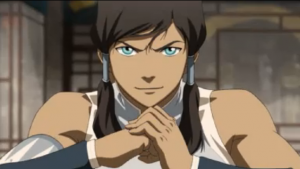
TLA begins with Aang avoiding his destiny as the Avatar. He froze himself beneath a glacier because he didn’t want to begin Avatar training and leave behind his childhood. S1 (and much of the later seasons) deals with Aang realizing that he can’t keep from becoming the Avatar – from growing up – while the world falls apart.
LOK has no such obstacles. We first meet Korra as a precocious four-year-old, flinging stone blocks and fireballs. “I’m the Avatar!” she yells. “You gotta deal with it!” She’s a clear contrast with Aang’s reluctance. She knows she’s the Avatar and she’s ready to claim the title.
Once she reaches Republic City, however, she learns that being the Avatar isn’t all it’s cracked up to be. It’s not enough to merely be an exceptional bender, if she causes as much damage as she prevents (like when apprehending a petty gang in E1). She has to be a representative to common people. She has to rely on official channels, such as the Council and the police, while also fighting corruption within those channels, such as Councilman Tarrlok and Chief Bei Fong’s replacement.
On top of all that, she has to deal with Amon. Amon is a uniquely terrifying villain, for reasons I’ll elaborate on below. He shows up without warning, always traveling with an armed and capable entourage. He’s an adversary of such power that only the Avatar can stand against him. Unfortunately, neither Korra nor anyone else know how to handle Amon.
Despite these challenges, the pressure does not let up on Korra. People keep asking things of her: Republic City’s yellow press, the Council, the common citizenry. She has to learn airbending, the elemental form to which she’s least suited – and lest you think Korra should just suck this up, recall that no one besides the Avatar ever has to learn a form to which they’re unsuited. Waterbenders are born waterbenders, and they’re discovered as waterbenders when they show an affinity for waterbending. It’s only the Avatar who has to train against type, and that’s in addition to learning how to talk to spirits, enter the Avatar state, and chi-bend.
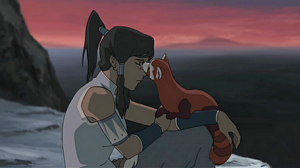
Korra discovers that having to live up to what people expect of you can be scary. It’s great to hear from adults and peers how amazing you are – how smart, how fit, how great at firebending. And being encouraged as a child is certainly healthier than being discouraged or belittled. But if you spend your whole childhood basking in the enthusiastic approval of authority figures, what happens when those authority figures turn to you for help? What happens when you have to deliver on a lifetime’s worth of expectations?
Korra’s desire to live up to what’s expected of the Avatar leads her to make some dangerous choices. She challenges Amon to a one-on-one duel. She joins a pro-bending league, putting her abilities to a public test. She confronts the most powerful member of the Council after he arrests her friends. This is more than would be expected of any bender – but it’s fully appropriate for the Avatar.
And Korra also gets scared. She never backs down from the challenges of her role as Avatar, but she grapples with a lot of private fears. Only her closest friends see the extent of her doubts. Korra deals with the challenge that all gifted children have to face – the world expects a lot of you. And if you’re not certain of what you’re supposed to do with your life – and no adolescent is certain – then that pressure to live up to the world’s expectations can either rush you into hasty decisions or overwhelm you with terror.
Dying Isn’t As Scary As Losing What Makes You Unique
The world of TLA is very pre-modern: steam power, written communications, swords and bows and boomerangs. People work very hard to subsist as farmers or laborers, with the world’s one mega-city, Ba Sing Se, being something of a novelty. They’re preoccupied with survival and freedom, as often happens in a world at war.
By contrast, the world of LOK is very modern: air and rail travel, wireless radio, shock gloves and mecha tanks. People are in less danger of dying or being sent to a labor camp. As happens during times of peace, attention turns inward. The great fear in peacetime is no longer dying or deprivation, but losing one’s humanity.
(This is also partly a function of having just survived a war. Consider the existentialist literature that followed WW1, or the restless Beat era that followed WW2, or the punk era that followed Vietnam. When we survive the destruction of war, we don’t worry about destruction; we worry about our souls)
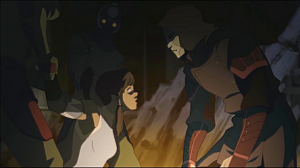
Into this bustling modern society comes the radical Amon. While Republic City is full of peace and optimism, there are enough disenfranchised people that Amon can find an audience. He speaks of upsetting the existing power structure through violent revolution, which is one of the harder sales to make. And he wields a unique and terrible power: the ability to take someone’s bending away.
As a narrative device, this is genius. It imparts the seriousness of an adult drama into a children’s cartoon. If Amon dragged benders onstage and executed them one at a time at gunpoint – a Republic City Che Guevara, if you will – it would never make it past Nick’s standards and practices department. Instead, he just undoes their bending. That’s all! See? They’re still alive. Perfectly safe for children.
Think about this a little longer, though, and you understand how terrible a fate this is. Benders get the power of bending through birth. They then spend years grinding that raw potential into a useful skill. Every bender enters into a social role that hinges on their bending talent. Nobody bends casually; nobody’s a radio correspondent who just happens to be an earthbender. If you can earthbend, then you probably work in construction, or architecture, or you compete as a pro-bender, or you shake down shopkeepers with a criminal triad.
Bending is your life. It’s a sixth sense you were born with, it’s a discipline you’ve spent decades honing, and it’s how you contribute to the social order. It’s how you identify to yourself and to others. And then, with very little fanfare, a masked stranger takes it away from you. All done.
We can’t be so callous as to say dying would be preferable to such a fate. But you can’t imagine the survivors of a bending removal are happy to be alive.
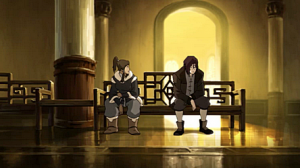
One of the great fears that modern adolescents share, as they enter adulthood, is the fear of losing some true part of themselves. This is why adolescents get so bitter and confrontational – they recognize the compromises and hypocrisies that adults have grown accustomed to, and they can’t stand it. Teenagers don’t want to compromise on their passions. They want to do what they want when they want it, and they can’t understand why anyone would want anything less.
(Teenagers also want to fit in with their peers, of course. The conflict between those two drives – fitting in and acting out – defines a lot of teenage drama)
The fear of losing one’s unique spark is a very adolescent fear. Adults tend to have either more prosaic fears – losing one’s job, losing one’s health, making an ass out of oneself at the Christmas party – or more profound ones, like what sort of legacy they’ll leave for their children. But they’re not as concerned with abandoning their inborn specialness. Maybe that’s because we’ve already lost that spark, but that’s a debate for another day.
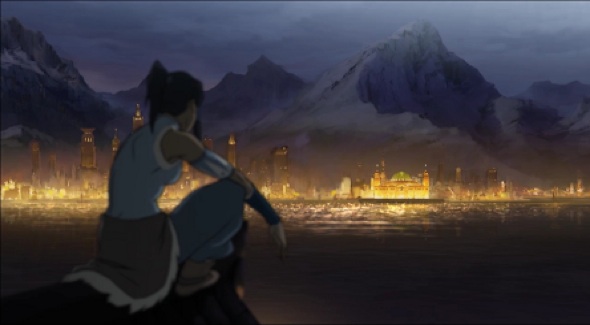
::slow clap::
I think Amon is set up as a great contrast to Korra and magnifies her internal struggles, sometimes even personifying them himself. Obviously,
SPOILERS
He starts out as a non-bender, and further, one that can make benders “like him,” so to speak, in the sense that he can take away their bending. The Avatar isn’t meant to bring life, no, but balance, and one could argue that it’s a blatant disruption of balance for a human to take away the bending powers of another. In essence, that bending-sucking power of his is a complete antithesis of that of an Avatar, metaphorically at first. And then actually, since in the season finale, Korra gains the ability to give benders their powers back. This makes me wonder if she’ll go further and grand bending to everyone, although I think that would be just a large of an infraction of balance as taking it away, so I doubt she would.
Then when we realize the truth about Amon, that he’s actually a water bender like Korra, it’s no surprise, but rather a demostration of the differences in choice and autonomy made by people with power. And that he’s a blood bender sets him up once again as her opposite. TLA does a good job of informing us that blood bending is the equivalent of dark magic and only the craziest or wickedest of persons would ever do it. So we see that while Korra has these great powers of bending in all elements, she chooses to do good with them, despite being a petulant teenager; whereas Amon uses the power of blood bending for atrocious acts of stripping bending powers and controlling people. In the end, Korra choosing and accepting and, in a way, needing her role as the Avatar, which is highly different than the (adorable) scene where she’s buzzing around spouting about it (it’s on a much deeper level, literally spiritual, since that’s the moment when she finally connects with all the other past avatars); that choice is what sets her free and gives her that ultimate power of bending-giving. Amon chooses constantly to only accept some of who he is and lets the conditioning of his (albeit crazy and rather terrible) father determine what he does, and that lads to his downfall (so it seems, at least), at he hands of his own brother, nonetheless.
Now I realize the avatar is conditioned to “bring balance” and stuff, too, but it isn’t until they truly accept it that they can.
So maybe another message to teens (or whoever) from both series is not one of believing in oneself, so much as accepting oneself. Embrace it. It’s more blatant in TLA, but I think Korra’s true acceptance of and desire for her destiny is shown in a subtler, more roundabout way. And I rather like that. It’s not beating me over the head, something that tends to happen with kids’ shows. And that’s one reason I loved the original, too- it had a lot of other things going on that were subtle.
Anyhoo, fabulous piece. I had been waiting for you to write something awesome, and I wasn’t let down.
Aw, thanks Gab!
Relevant, particularly the first point:
http://kotaku.com/5923014/5-ways-the-legend-of-korra-went-wrong?utm_campaign=socialflow_kotaku_facebook&utm_source=kotaku_facebook&utm_medium=socialflow
There’s some legitimate critique there, and a good parallel with X-Men.
Great article! I just discovered this site and I am having a blast so far.
I loved the theme of bending privilege this show had and I hop they keep it going throughout the shows run. I don’t think Korra and the rest are done with The Equalists just yet.
Like the article mentioned this world has advanced a great deal in the 70 years since TLA. We know from the season finale that there has been countless avatars before Korra. Their civilization must go back thousands of years. Yet their technology is only now progressing at what we would consider normal levels.
I think the reason for this is the 100 year war from the first series. Between the benders who died during the war and the ones The Fire Nation imprisoned the worlds bending population must have dropped drastically (Not to mention the genocide of the Air Tribe). In the pre-war world their were plenty of benders to handle everything their society needed. After the events of TLA non benders were forced to pick themselves back up and they developed advanced technology to do it. For the first time in history regular people had the numbers and power to create real change on their own. This sets the stage for the conflict in Korra.
Now that there is peace the bending population is growing. The power the normal humans have grown accustomed to is evaporating. I don’t believe they wish to go back to being second class citizens. Non-benders created power plants and now fire benders are taking their jobs. Bending gangs harass shop keepers. Even the ruling council is made up of all benders.
Amon had a very easy time getting the people to come along with his line of thinking. I think its funny that blood bending is so feared that is must be banned. Most benders are powerless against it so it makes sense that they would outlaw it but think about it from the perspective of the normal human. To them blood bending isn’t any scarier than getting burned to death or having a giant boulder dropped on your head. Isn’t this prohibition against blood bending just the ruling class creating equalist laws for themselves? Why not ban all bending then?
I’ll be very disappointing if season 2 abandons the Equalist storyline for some generic villain. This show has the opportunity to really mean something.
I do think it matters whether or not non-benders are actually oppressed. It really takes me out of the story when I have to figure out why the entire city is so anti-bender. It makes sense that non-benders would have a certain amount of resentment towards benders. At the end of The Last Airbender, benders were mostly a military class. In the 70 years between the series, however, that has changed. An era of peace and the rise of technology have rendered most benders redundant. The first few episode seem to indicate that the benders’ position is similar to that of samurai in Japan’s Meiji period. Some bending families were able to use their resources to maintain their status in the new social order, but many were simply not able to adjust, becoming thugs and beggars. I have a hard time believing that so many citizens would feel so strongly about benders when those benders don’t actually occupy a position of privilege.